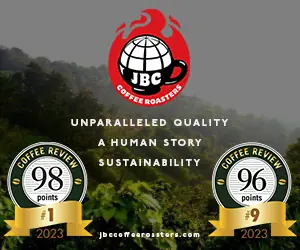Ever since specialty coffee pioneer Alfred Peet popularized Sumatra coffees on the menu of his famous Vine Street store, their pungently fruity, earthy/musty profile has attracted a loyal following among American coffee lovers. Along the way they have been regularly tagged “mysterious,” a word also often applied to the seldom-visited Indonesian island they come from. Well, mysterious no more, or at least not as mysterious. The specialty industry is meeting the mystery and understanding it, sort of.
This month’s cupping of Sumatra coffees could be seen as an early test of the industry’s post-mystery understanding: Were this month’s forty-three Sumatras from thirty-one North American roasting companies any more impressive than a similar set might have struck us some years ago? In 2005, for example, when we did our last Sumatra-focused review article? Definitely, although this month’s evidence remains mixed. We tasted coffees ranging from exceptional examples of the new more refined style of Sumatra profile to many solid examples of the older, more explicitly earthy style to one or two samples that were, in our view, barely acceptable as specialty.
One Mystery Resolved: Wet-Hulling
First, however, why was this coffee type labeled mysterious in the first place? A simple answer is that until recently not many American coffee insiders visited Sumatra. But certainly a second reason is the unorthodox nature of the Sumatra cup profile, which defies standard American specialty coffee understanding. The source of the characteristic flavor note of the most admired kind of Sumatras, a mild musty mildew crossed with mild fruit ferment, violated the most sacred tenet of traditional specialty coffee: that the flavor impact of fruit removal and drying ought to be as invisible as possible, and any interference imparted by those processes to the “pure” taste of a perfectly processed, squeaky-clean coffee was worthy of denunciation from the high pulpit of the specialty coffee priesthood. So for years the specialty industry danced around traditional Sumatra coffees, avoiding attempting to really understand them and creating competitions and cupping forms that essentially marginalized the potential of the type.
But now the peculiar post-harvest procedure that facilitates their flavor profile finally has a name: “wet-hulling.” In the years since I first saw these unorthodox procedures first hand in 1996 I applied various names for them in my books and articles: “traditional Sumatra processing,” “backyard wet-processing,” etc. None of these names impressed. But when the Australian coffee scientist Tony Marsh delivered a paper at the 2009 Specialty Coffee Association of America Symposium that described these techniques in detail and dubbed them “wet-hulling,” the new name and the understanding to go with it stuck.
We now know that the odd pungent musty fruity character of traditional Sumatra coffees is mainly created by removing (hulling) the parchment skin of wet-processed coffee while the beans are still moist and resilient (or “wet”), and finishing the drying of the coffee after the removal of the parchment skin. (Normally the parchment skin is left on the beans throughout the drying and subsequent storage.) I know, this variation doesn’t sound like a big deal, but in terms of impact on flavor it is.
Furthermore, in recent years some leading exporters and producers appear to be working from a better understanding of these traditional procedures and applying them with increasing sophistication. In other words, what has been a traditional, rather haphazard procedure with accidental impact on coffee flavor now seems to be applied with increasing deliberateness by certain producers to achieve a more consistent version of that flavor impact.
Sumatra Revolution?
Where are we now? At the beginning of a Sumatra coffee revolution, I hope, in which green coffee buyers no longer need to sort through various accidental versions of the profile to find a good one, but will be presented with refined versions of the profile from the get-go. I also expect that as the wet-hulling technique is increasingly understood we may have wet-hulled coffee from more places than Indonesia alone – not entirely good news for Indonesians, given that many of their coffees rely on traditional wet-hulling for their distinctive character. I have, in fact, just cupped a very impressive and authentic-tasting version of a wet-hulled coffee that was created in Hawaii.
Based on the cup, most of the coffees reviewed this month appear to be versions of the best style of traditional wet-hulled profile, in which the musty/earthy note constitutes a backgrounded complication and enrichment of an essentially fruit-derived character. At a medium roast this flavor complex is fascinating in its various permutations. For me the dominant note typically reads as sweetly pungent citrus or grapefruit. But others read butterscotch (a favorite in some circles), cedar-toned citrus, tart berry, etc. Nevertheless, the essential character of this note is a combination of pungency (I assume a hint of mustiness) with a rich, sweet fruit. High-rated versions of this cup profile reviewed this month include the Batdorf & Bronson Lake Tawar (94), Barrington Sumatra Lintong Iskandar (93), Paradise Coffee La Minita Aceh Gold (92), and Klatch Coffee Sumatra Bodhi Peaberry (91).
We did review some examples of the more traditional, explicitly earthy kind of Sumatra for those who enjoy the mildly foresty roughness of this older-fashioned style. Finally, we included one coffee that reads more like a rather wild dried-in-the-fruit natural, but apparently is simply a wet-hulled coffee with some serious, if creative, engagement with musty/earthy ferment: The Mud Bay Permata Gayo (87) will appeal mainly to coffee sensibilities that enjoy rough, wild impressions in beverages, analogous to those experienced in mescal or Isley whiskies.
2010 The Coffee Review. All rights reserved.












